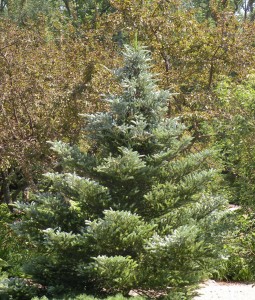
Bi-color conifer Abies koreana ‘Horstman’s Silberlocke’
In the depths of winter, particularly in cold climates, we always seek signs of life. Plants with foliage color throughout the year help fill that bill. While we often think of conifers for winter color, it is helpful to know that many perennials retain their colored foliage during the winter.
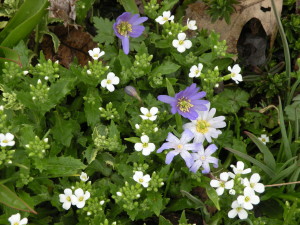
Arabis caucasica with Anemone blanda in my garden in April
One of my favorites is Arabis caucasica (Rock Cress). A tightly spreading, very short groundcover, its dentate foliage is fuzzy green. The most common cultivar is ‘Snowcap’ but there are also two rosy pink cultivars that are widely available, ‘Compinkie’ and ‘Spring Charm’. There is also a variegated leaf form but, unfortunately, over time, it reverts to all green. This charmer needs full sun and good drainage.
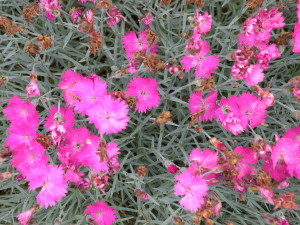
Dianthus gratanopolitanus ‘Firewitch’
Most Dianthus remain evergreen. For me, the best performer is an old cultivar called ‘Bath’s Pink’. It has been a mainstay of my back perennial bed for twenty years in spite of the fact that the drainage is less than perfect. I love its blue foliage that remains a constant even though the pink flowers only bloom for about a month. Another excellent cultivar is ‘Firewitch’. The foliage of both is about two inches high while the blooms are six inches high. Once they finish blooming, just give them a good haircut so don’t have to look at the deadheads. Like all Dianthus, grow in full sun.
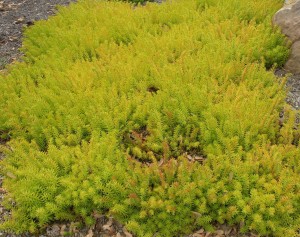
Sedum ‘Angelina’ en masse taken a client’s garden in May
Some of the groundcover sedums retain their color during the winter. Sedum ‘Angelina’ is well-known for its bright yellow, needle-like foliage. You almost don’t notice the flowers when it blooms because they, too, are yellow. During the winter, the foliage takes on an orange tinge that makes it even more interesting. Much less known is a blue sedum that retains its color all year, Sedum hispanicum (Blue Carpet Stonecrop). Its foliage is smaller and the flowers are white. Both of these sedums need full sun.
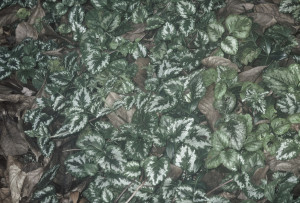
Lamiastrum galeobdolon in December
There are several evergreen perennials for shade. A great groundcover is Lamiastrum galeobdolon (Yellow Archangel). How’s that for a mouthful? The variegated foliage is displayed on long runners that root wherever the runners touch the ground. Yellow-flowered spikes arise in May.
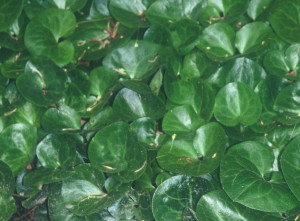
Asarum europaeum
Another evergreen perennial for shade is Asarum europaeum (European Ginger). The leaves are shiny and heart-shaped. It is often listed as a groundcover but use it in a small space because it spreads very slowly. The foliage is only a few inches high. It has unusual flowers but you literally have to kneel on the ground and look beneath the leaves to see it.
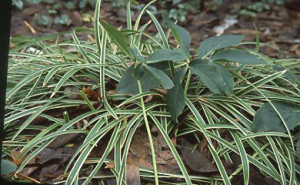
Carex morrowii ‘Ice Dance’ with Helleborus orientalis in my dry shade in January
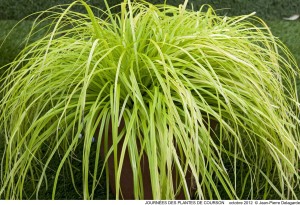
Carex oshimensis ‘Everillo’ – Thierry Delabroye
Don’t forget that some of the sedges remain evergreen. Carex morrowii ‘Ice Dance’ has green and white foliage that looks great in the shade during the winter. Although it grows fine in the sun with enough moisture, the foliage will burn during the winter. I have fallen in love with Carex oshimensis ‘Everillo’. Its yellow (in sun) /chartreuse (in shade) foliage is a keeper. It brightens my day whenever I look out the window to the back garden. Both sedges grow approximately twelve inches high and wide.
By the time you read this, the ground may be covered with snow but if not you or your clients would delight if any of these perennials or sedges were in the garden.


1 Comment